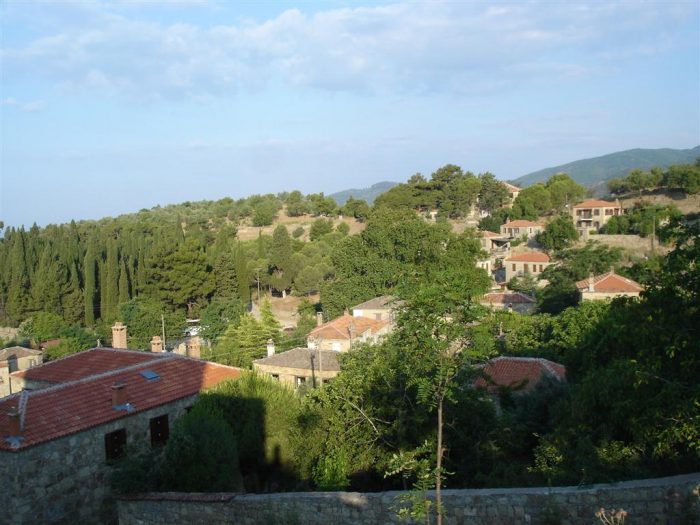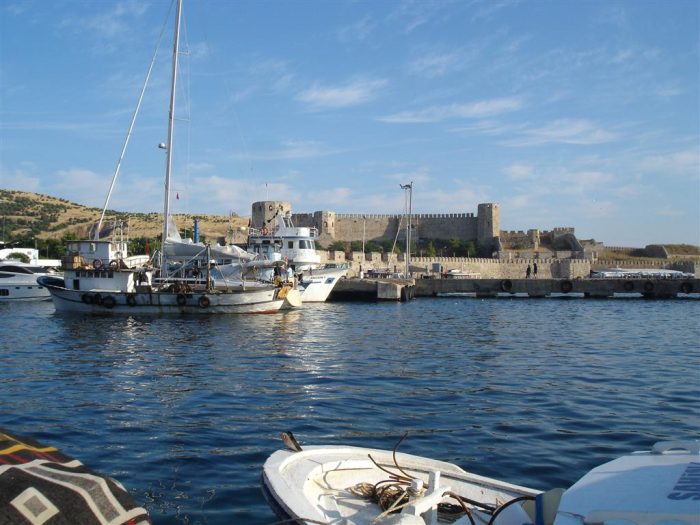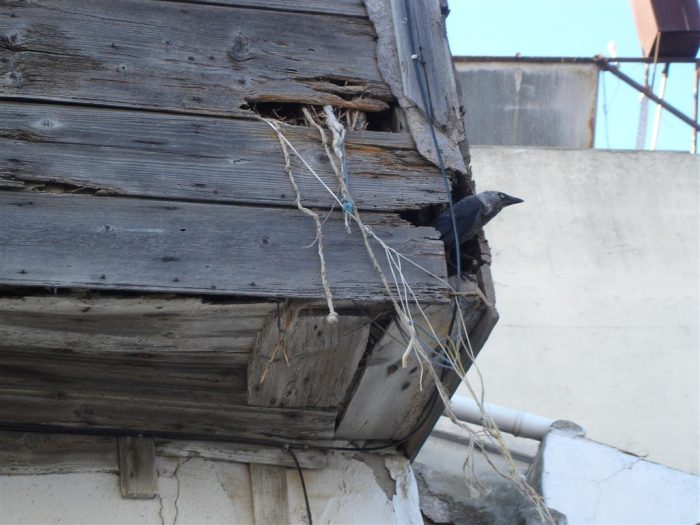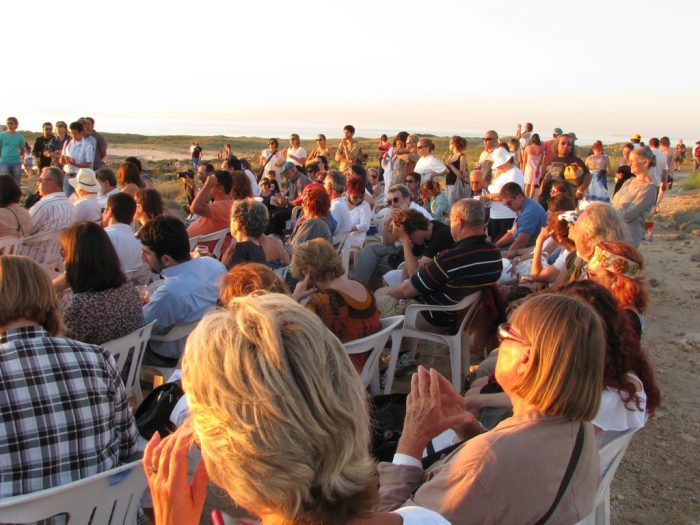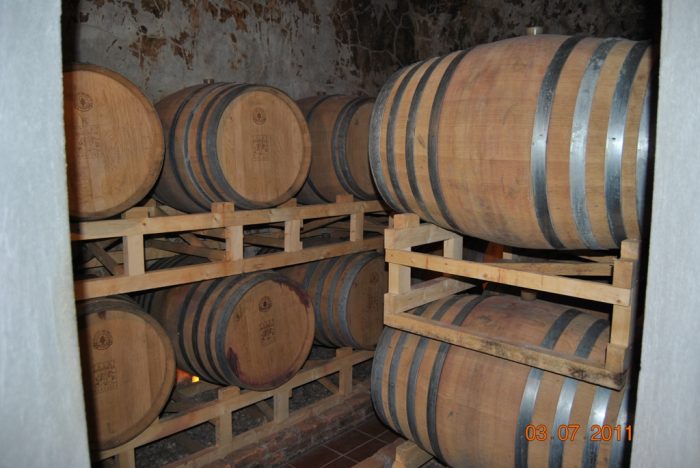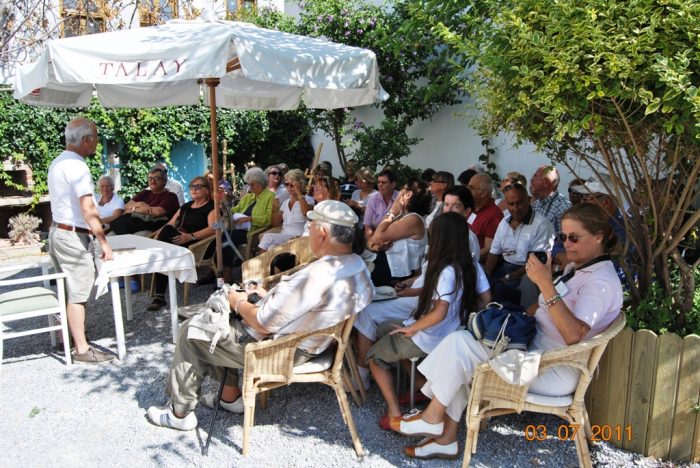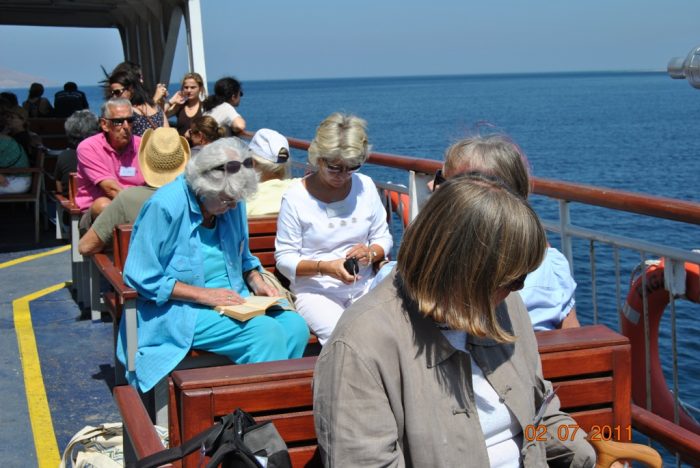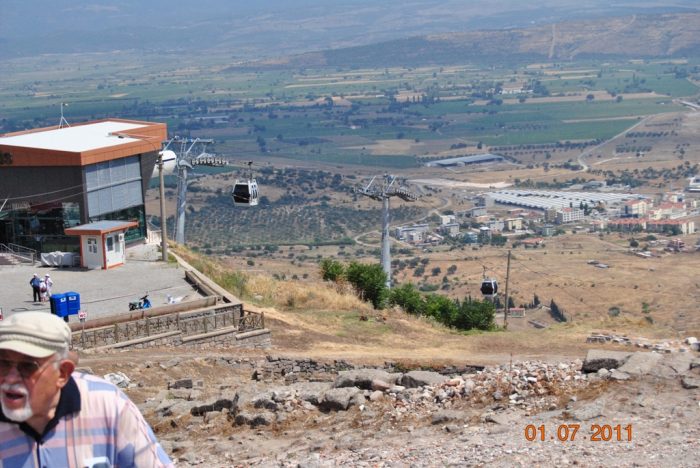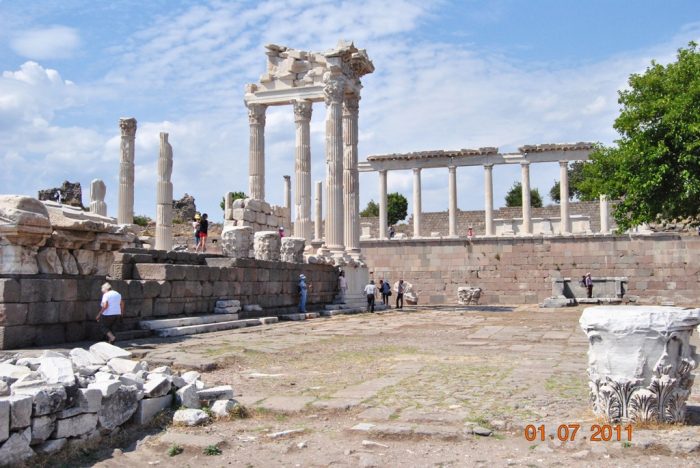Day 1, Friday 1 July
Thirty seven member of the Herodotus Third Age Academy (H3A) and their friends joined H3A’s tour to the North Aegean, organised by Meris Tur, leaving Bodrum soon after eight o’clock in the morning.
The main objective of our journey was to reach the western most point of Turkey the next day and at sunset to read from Homer’s Odyssey in several languages. Homer tells of Odysseus’s ten year journey home to Ithaca after the end of the Trojan Wars. From his epic poem the English word odyssey is derived – a long journey during which many things happen.
Our journey measured over 1400 kilometres, but took only four days to complete compared to Odysseus’s ten years and though many things happened along the way they were somewhat less dramatic than those experienced by Odysseus.
Our first stop after leaving Bodrum was at Lake Bafa, once a gulf of the Aegean but left behind as a lake as the sea retreated.
We then travelled without a break to the town of Bergama (Pergamum) where we fortified ourselves with a good lunch before tackling two of the principal archaeological sites – the Acropolis and the Asclepion.
We reached the Acropolis by cable car. A daunting experience for those who don’t like heights – groups of eight people boarding a moving cab before it set off up the mountain, swinging above the valley.
On arrival we learned from our member, Semih Adyıman, about the history of Pergamum (see below) and about the main structures. These include the library and the marble-columned Temple of Trajan, built during the reigns of the emperors Trajan and Hadrian and used to worship them as well as Zeus. Rebuilt by the German Archaelogical Institute, it’s the only Roman structure surviving on the Acropolis. The foundations were used as cisterns during the Middle Ages. The overall design of the vertigo-inducing 10,000 seat theatre was borrowed from Hellenistic architecture, but the theatre builders made major modifications. The usual rounded shape proved impossible to achieve because of the slope and it was increased in height instead.
Below the stage is the ruined Temple of Dionysus. The Altar of Zeus, south of the theatre and shaded by evergreen trees, was originally covered with magnificent friezes depicting the battle between the Olympian gods and their subterranean foes but 19th century German excavators removed most of this famous building to Berlin with the sultan’s permission. Only the base remains.
Piles of rubble on top of the Acropolis are marked as the Palaces of Attalus I and Eumenes II, and there’s an agora (assembly) as well as stretches of magnificent defensive walls.
Across the valley to the west we could see the Asclepion where we now headed after descending to our bus vıa the cable car.
Pergamum’s Asclepion was an ancient medical centre founded by Archias, a local citizen who had been treated and cured at the Asclepion of Epidaurus in Greece. Possible treatments included massage, mud baths, drinking sacred waters, and the use of herbs and ointments. Diagnosis was often by dream analysis. Peragmum’s centre came to the fore under Galen (AD 131-210), who was born here, studied in Alexandria, Greece and Asia Minor, and set up shop as physician to Pergamum’s gladiators.
Recognised as perhaps the greatest early physician, Galen added considerably to knowledge of the circulatory and nervous sytems, and also systematised medical theory. Under his influence, the medical school at Pergamum became renowned. His work was the basis for all Western medicine well into the 16th century.
Patients slept in the Temple of Telesphorus, another god of mediicine, hoping that Telesphorus would send a cure, or at least a diagnosis, in a dream. The names of Telesphorus’ two daughters, Hygeia and Panacea, have passed into medical terminology.
Day 2, Saturday 2 July
After an overnight stop in Güre near Edremit, we journeyed on over Kaz dağları (Ida mountains) to Geyikli to board the ferry to Bozcaada one of the two inhabited Aegean islands. Windswept Bozcaada (formerly Tenedos) is known for its wines (Ataol, Talay, Aral, Corvus and Yunatçilar). A medieval fortress towers over the harbour. In its wake huddles one of Turkey’s least spoilt small towns, a warren of picturesque, vine-draped old houses and cobbled streets. Herodotus said ‘Bozcaada was made to make men happy’. PossibIy he was talking about the wine for which it was famous even then.
Lunch was followed by a visit to the Bozcaada local history museum where the museum’s founder, Hakan Gürüney, gave us a presentation and this was followed by an ud recital at the Talay wine factory.
After an early dinner we achieved our objective – reading in several languages from Homer’s Odyssey and watching the sunset from the shores where their journey had started over 3000 years ago at Cape Polente. The languages included Turkish, English, Japanese, German, Italian – and Finnish read by our member Enis Arkun.
The English version begins ‘All the survivors of the war had reached their homes by now and so put the perils of battle and the sea behind them. Odysseus alone was prevented from returning to the home and wife he longed for by that powerful goddess, the Nymph Calypso, who wished him to marry her, and kept him in her vaulted cave. Not even when the rolling season brought in the year which the gods had chosen for his homecoming to Ithaca was he clear of his troubles and safe among his friends. Yet all the gods were sorry for him, except Poseidon, who pursued the heroic Odysseus with relentless malice till the day when he reached his own country…’
The meeting was chaired and organized by Haluk Şahin, the brother of H3A’s president.
Some of us then attended the 10th anniversary of the ‘poet of the year’ event, directed by laureate poet Professor Cevat Çapan, and the presentation of this year’s award to Hakan Savli around a camp fire at Mitos Beach.
Day 3, Sunday 3 July
The first event of the day was a discussion with Dr Rustem Aslan on the significance of Troy in Archaeology in Itırlı Bahçe (perfumed garden) – a meeting place for those interested in the cultural affairs of the region which geographically and culturally includes the Greek islands of Lesbos, Limni and Samothraki as well as Turkish Gökçeada (Imbros) and the Dardanelles Region as a whole.
As related in Homer’s Iliad, Troy is the stuff of high romance, of the war which began between the Greeks and the Trojans when Paris, the son of King Priam of Troy abducted Helen, the wife of King Menelaus of Sparta who launched a thousand ships to bring her back.
Who was Homer and was the Iliad history or myth? Homer was a blind storyteller who travelled around the coasts of Greece and Asia Minor. His epic poetry, written in hexameter, was performed by singers. The Trojan Wars ended in 1250 BC but Homer lived 500 years later. Until German-born amateur archaeologist Heinrich Schliemann (1822-90) came along it had always been assumed that the great poetry of Homer was based on legend, rather than history. But Schliemann got permission from the Ottoman government to dig at the mound (tepe) of Hisarlik at his own expense and uncovered four ancient towns, more or less destroying three others in the process.
Schliemann has been dismissed as a treasure-hunter whose primary interest lay in uncovering the treasure of King Priam. Schliemann eventually had to concede that the treasure he found had belonged to a queen or princess who lived 1,500 years earlier than Priam. The treasure disappeared during WWII and was only recently discovered in Russia. It’s now in Moscow’s Pushkin Museum, the subject of an ongoing dispute.
Troy is a difficult site to understand because excavations have revealed nine ancient cities, built one on top of another and dating back to 3000 BC. The first people lived there during the Early Bronze Age. The cities called Troy I to Troy V (3000-1700 BC) had a similar culture, but Troy VI (1700-1250 BC) took on a different character, with a new population once thought to be Mycenaean. However, when their pottery was analysed it was found to be locally made and is therefore Anatolian. In an important geopolitical position Troy controlled the Dardanelles until the nearby river estuaries silted up and Troy was no longer on the coast.
Troy VII lasted from 1250 to 1050 BC and was in decline until it was revived as a Greek city (Troy VIII 700–85 BC) and then as a Roman one (Troy VIX 85 BC to AD 500).
It cannot be proved conclusively that Hisarlik is the site of Troy but archaeologists have logical evidence which shows that it has to be. Furthermore the description of the landscape in the Iliad is similar to that around Hisarlik.
The group then split up, some staying on to listen to Dr Aslan speak on Flowers in Homeros epics and archaelogist and publisher Nezih Başgelen on Rivers in Homeros epics; the others visiting on the local wine producers, shopping for local wines and tomato jam.
After lunch we left Bozcaada for Troy taking a detour which afforded us a view of the coast of Gallipoli across the straits of the Dardanelles. For thousands years these straits have been the key to Istanbul and the Black Sea: the navy that could force the straits had a good chance of capturing the capital of the Eastern European world. Many fleets have tried to force the straits. Most, including the mighty Allied fleet mustered in WWI, have failed.
On arrival at Troy, Semih Bey, in the shade of the Trojan Horse, (designed by Turkish artist Izzet Senemoğlu) explained how Odysseus dreamed up the idea of using the horse to defeat the Trojans. But was there a Trojan War? In Homer’s Iliad, Troy was the town of Ilium where the Trojan Wars took place in the 13th century BC. They lasted ten years and created such heroes as Achilles, Hector and Agamemnon. Odysseus brought them to an end with the construction of the Trojan Horse. Made of wood, its hollow belly was filled with Greek soldiers who took the city once they were inside it, hence the warning, ‘Beware of Greeks bearing gifts’. For more on the history of Troy, see below.
We spent that night at Adatepe village on the foothills of Kazdağları (Mount Ida), surrounded by olive trees and pine forests. Beside the diversity of its rich flora and fauna, Ida is also well known for its high level of oxygen. The air is so clearn that star gazing is a regular evening event. Adatepe village is under protection as a natural and historical heritage site.
Day 4, Monday 4 July
Our journey home. After relaxing in Adatepe village, we visited their Olive Oil Museum in Küçükkuyu for shopping. Then to lunch at the Lyra Restaurant, Cunda Island, Ayvalik before returning to Bodrum.
Our profound thanks go to Meris Tur for arranging the transport and accommodation and to Selçuk and Camılle Şahin for their meticulous organisation in making the tour so memorable.
History of Pergamum
Pergamum appears to have been founded by Aeolic Greeks in the eighth century BC. We first hear of it in Xenophon’s Anabasis. After the death of Alexander the Great, Lysimachus, one of his generals became master of the city, but was ousted by Philetaerus, who became first king of Pergamum. He bequeathed his crown to his nephew Eumenes I who in turn bequeathed it to Attalus I, one of his cousins. It was during the reign of Attalus that the Galatians (a horde of Gauls) in the course of their migrations, attacked Pergamum, but were defeated in 230 BC. This victory Attalus celebrated by a number of statuary groups, some of which are extant, including the celebrated Dying Gaul (wrongly called Dying Gladiator) immortalised by Byron, and now at Rome.
The kingdom reached its greatest extent after the defeat of Antiochus the Great by the Romans (190 BC) when the Romans gave Eumenes II the whole of western Asia Minor and Pamphilia. The most brilliant period of Pergamene history is the reign of Eumenes II (197-159 BC). It was he who set up the great altar of Zeus, adorned with sculptures. These sculptures have, since their recovery during the excavations begun in 1878, revived the fame of Pergamum. It was also under Eumenes II that the celebrated library was founded at Pergamum, the formation of which occasioned the invention of parchment, Charta Pergamena. The library was afterwards transferred to Alexandria by Cleopatra to whom Antony had given it. On the death of Attalus III (133 BC) the kingdom passed, by a bequest of his will, to the Romans. The only reference in the New Testament to Pergamum is in Revelations, where it is described as possessing the seat of SATAN which probably refers to the altar of Zeus. The Pergamene school of sculpture was celebrated in antiquity, and was largely influenced by Lysippus and by the Parian Scopas.
Today, the most important monument to be seen of ancient Pergamum, the Victory Altar of Eumenes II, was discovered in the 1890s and removed to Berlin where it miraculously survived the destruction of World War II. What remains in situ is spread over three areas.
The Acropolis, atop a tremendous rock, holds the ruins of a royal citadel, an impressive theatre, a temple of Trajan, the substructures of a gymnasium, and somewhat lower, a fascination section of Roman-era houses and shops which were laid free by recent excavations.
In the old town below the hill, which is of considerable interest itself for its quaint old-Turkish character, are the remains of a gigantic Temple of Serapis (The red Basilica) dated to 100 AD. At some distance from the town, finally one finds the widespread ruins of the medical complex of the Asclepium, the ancient world’s leading centre of medical therapy and research. Famous practicioners at the Asclepium included GALEN, the Roman physician whose writings formed the basis of Western medical knowledge until the end of the Middle Ages.
Notes from Sir William Smith, Aileen Lau, Bina Maniar,Terry Richardson and others.
History of Troy
Troy is the scene of the famous Trojan War undertaken by the Greeks (under the leadership of Agamemnon and Menelaus) to recover Helen from Paris, son of Priam, who had eloped with her. German-American adventurer-businessman-antiquarian Schliemann’s explorations on the site of the ancient city have proved that there is evidence for what was once regarded as mere legend. Nine distinct settlements in Troy have been counted; but there were probably more, so that the history of the town comprises something like 3500 years. The Mycenaean settlement (now called the sixth city) dates from 1500 to 1100 B.C. This was the period of Troy’s greatest splendour. Homeric Troy is ondoubtedly the sixth city, not the earlier-or ‘second city’, as it is termed — which Schliemann discovered. The hillock on which Troy was built was flat until the second city (3000 BC) but, with successive settlements, it assumed a conical shape. Huge walls were built by the Trojan rulers, and the lower portions of these still remain.When the romans came to Troy they swept away the local buildings in the centre of the city.
The position of Troy is peculiar; it lies at the end of a sloping ridge just where it runs down to the plain.On the west side of the Scamender (Karamenderes) flows through a swampy plain: on the north runs the Simois. The reason for this position appears to be that it is the natural meeting place for the traffic of the Black Sea with the Aegean. The Black Sea was important from a mercantile point of view. Troy may be regarded as the combination of fort, palace, and warehouse. The so called siege of Troy really represented the efforts made by the Greek traders to break a trade monopoly long enjoyed by the feudal princes of the city.
A
lthough there’s no way of proving that the TROJAN WAR did take place, there’s a fair amount of circumstantial evidence suggesting that the city was the scene of some kind of armed conflict, even if it wasn’t the ten year struggle described in the ILIAD. It’s possible that Homer’s epic is based on a number of wars fought between Mycenaen Greeks (Achaeans) and the inhabitants of Troy, who were by turns trading partners and commercial rivals.
The traditional date of the fall of Troy under Priam is 1184 BC: ”when night fell, the Greek soldiers hidden inside the wooden horse , leapt out, fired the city, and wreaked a bloody slaughter on the Trojans. King Priam was butchered at one altar, his daughter, the prophetess Cassandra, raped at another. The child Astyanax, Hector’s son was hurled from the walls. The men were massacred and the women taken into slavery. Troy was no more”
According to Roman legend, only Aenas escaped carrying his father Anchises on his back and leading his son Ascanius; he sailed westward and in due course reached Italy where he founded the settlement that was to become ROME.

